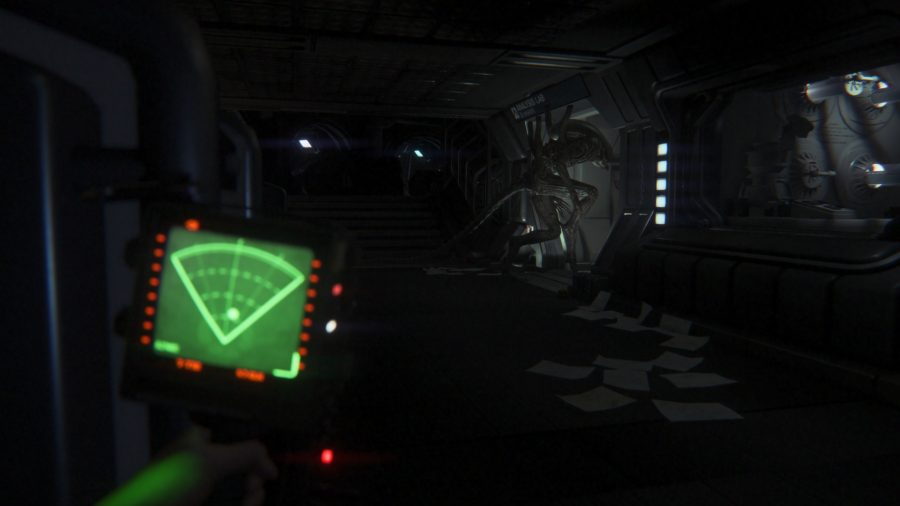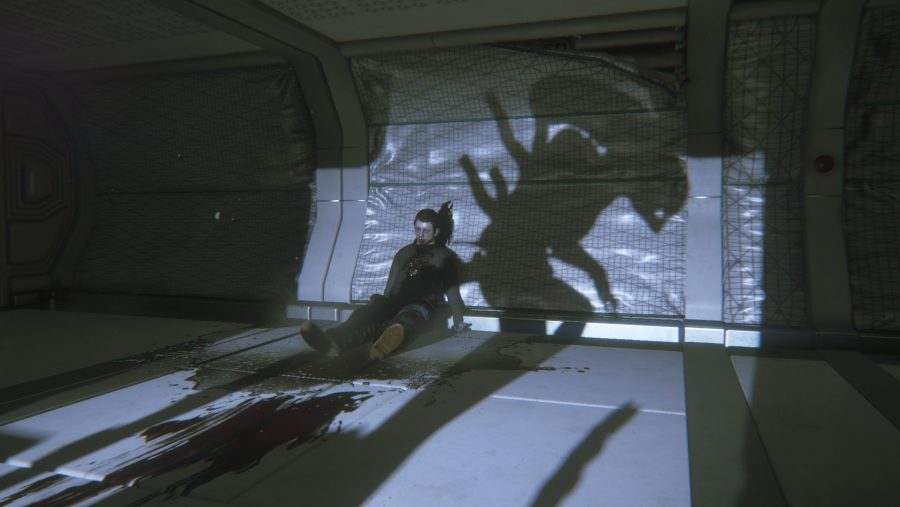Our Verdict
A monster of frightening intelligence dwarfs some minor missteps as Creative Assembly delivers the best and most authentic Alien game ever made.
Alien: Isolation is a first person stealth horror game in which you, a human full of the blood and guts you require to survive, must hide from and evade an eight foot tall alien creature who wishes to poke a hole in you such that all of your blood and guts spill out on to the floor.
It is this narrative conflict, this dramatic dispute over whether your insides should be inside of you, that is central to Alien: Isolation. It’s a terrifically scary game by The Creative Assembly, a studio who’ve expertly engineered an alien AI of such worrying cleverness that I’m not totally convinced it hasn’t crept out of my monitor and is standing behind me right this second.
In Alien: Isolation you find yourself stranded aboard the derelict space station Sevastopol, a far flung freeport brought to its massive metal knees by looting, panic and violence. As well as a few dozen human stragglers, the station also hosts a small operational crew of rudimentary androids who’ve seemingly gone a bit menacing, switching their eye-LEDs from “courteous white” to “murderous red” and pacing around with their hands held up in a throat-grabbing pose.
Quite why everything’s gone tits backwards on the Sevastopol is a mystery. You play as Amanda Ripley, showing up to the station hot on the space-heels of the flight recorder of the Nostromo and eager to find out what happened to your mum, Sigourney Weaver.

Weapons do very little to discourage the alien. In fact, firing a gun will only draw its attention to your position. Instead it’s best to hide under tables, inside lockers and behind crates. The alien will stalk you if it reckons you’re nearby, investigating corners and sniffing around cupboards until it either finds you or gets bored and wanders off. You can peek over edges and around corners to plan your next move, though not without risking being spotted. You’ll come to recognise the sounds it makes, the telltale thuds of its feet as it approaches or moves away, or the bassy “cha-clunk” of the beast retreating into the ventilation system, a sign that it’s momentarily safe to come out of hiding and proceed on your way.
After more spooks? Check out the best horror games on PC
The alien can return at any time. The sound of sprinting will summon it for example, as will opening doors and bashing things with your wrench. The alien is a constant, unscripted and exhausting psychological threat that follows you throughout the game.
It’s just as unpredictable in when it chooses to be absent. You’ll explore entire areas of the Sevastopol without once encountering the alien, only to reload from an earlier checkpoint and find it now constantly harassing you. In one instance you’ll escape the alien by diving into a locker and peering out through the narrow slits, watching the thing pacing back and forth as its little virtual brain desperately tries to figure out where you’ve disappeared to. In another instance you’ll try precisely the same tactic, only to have the alien wrench the locker door from its hinges and violently turn you into a crumpled wet mass of bones and meat. The creature’s diverse behaviours are no more apparent than in the game’s quickfire Survival mode, which effectively locks you in a box with the thing and challenges you to get out alive.
You can’t elicit a guaranteed reaction from the alien. Flares and improvised noisemaker grenades will draw its attention away from you temporarily, but even these tactics aren’t reliable. As the game progresses the alien will be fooled less and less by distractions, soon giving up on investigating whatever it is you’ve chucked over its head and instead trying to figure out who’s doing all the chucking. The alien is smart and requires outsmarting.
It’s a convincingly clever stealth opponent, one that’s not obviously driven by cones of vision and attention timers but instead by subtle behavioural programming and a slowly developing intelligence that somewhat resembles sentient learning. It wouldn’t surprise me if by the end of the game the alien figures out a way to drive the game’s .exe file menacingly around your desktop.
A design rule of not including any objects that could not have been built on the set of the original film holds fast throughout the entire game, lavishing incredible detail on the Sevastopol’s quarters and halls and corridors. The place feels lived and worked in, from the padded white walls and clinical lighting of the medical wing to the more cramped industrial refinery decks. A staggering amount of thought has gone into the lighting of every corridor, into the shapes of the doors that connect them and into the weirdly insectoid clacking of the old hard drives.
And there’s stuff to find there too, little easter eggs that reward backtracking, as well as scrap and materials that can be used to build things to throw at the alien or at hostile humanfolk. Audio diaries are littered about the place, with the cast of the Sevastopol graciously having taken the time to commit all of their dirtiest secrets to tape. You can also access computer terminals to read emails, discover even more audio diaries or access certain systems to open doors or activate things in the environment.
Typically, your efforts to explore the Sevastopol will be hampered by your delightfully interfering alien friend, though for chunks of the game you’ll instead contend with more human-shaped enemies. Here, your best bet is still to hide and sneak your way around, but detection by a fellow humans tends to play out differently.
Where no one can hear you scream: The best space games on PC
Some of the more chill survivors will caution you before they shoot, demanding that you stay back or they’ll open fire, while others will attack on sight. Not only are bullets detrimental to your well-being, but gunfire very quickly attracts the more dangerous of the station’s predators. Under the right circumstances this can work in your favour, causing human enemies to scatter as the alien blindly attacks any warm-blooded creatures it can find.
It murders quickly and efficiently — and, it’s worth mentioning here, not especially graphically when you’re witnessing another NPC dying at its hands — but while the alien is busy you’re often left with just enough time to make an escape.
Androids form a secondary horror in Alien: Isolation, emotionless robot-men who stride purposefully towards you at a relaxed yet determined pace. Like the alien, these guys are largely impervious to your attacks (they’re also ignored by the alien) and must instead be circumnavigated. They’ll erupt into flames if hit with a molotov or flamethrower, before continuing to march towards you, unfazed and leaving fiery molten footprints as they go. Their pre-programmed, scripted helpfulness is entirely at odds with their madly malfunctioning violence. “Don’t run. You’re being hysterical,” they intone calmly as they smash your skull into nearby walls. “Why don’t you ask me about Sevastopol’s safety procedures?”
The ratio of alien to synthetic android to human combat shifts a few times throughout the course of the game, occasionally even allowing you enough distance from the alien to let you play with shotguns and revolvers without attracting it. As such there’s a gentle turnover of pacing across the game’s 15-20 hours of play, with the genuinely exhausting tension of cowering from an unseen monster offset by moments of relative calm as you hide from murderous androids. There are a few more notable moments of respite too, surprising inclusions that will thrill fans.
However, it’s not all aliens and murder and blood and fun and screaming and goodness. Alien: Isolation could easily be about half as long as it is. The last third of the game is enthusiastically padded out with a frankly stunning number of generators to find and restart. Objectives become so side-tracked by gradually mounting disasters and diversions that you’ll soon forget why you’re doing whatever it is that you’re doing. You’ll slowly realise that your means of interacting with the world in a non-combative context boils down to the six or seven means you’ve got of opening a locked door.
And you’ll really struggle to care about any of the game’s characters, even Amanda herself, a woman so comically bland that I’m surprised the alien doesn’t mistake her for a synthetic. Androids get a free pass for appearing robotic, but other humans walk about like weird meat puppets on tracks, not even nearly matching the fidelity afforded to the surroundings, or to the alien itself. Throughout, the plot is conservative and will be overly familiar to anybody acquainted with the franchise, and the ending is confusing and weirdly abrupt.
But hey, that big alien galoot has clever enough shoulders to carry the game’s shortcomings, and while the incredible achievement of creating this terrifying intelligence hasn’t extended to every area of Alien: Isolation, as a complete work it amounts to at least the most authentic Alien game ever made.
And with the game’s unwavering deference to the film’s cinematic world building and detail, and its skillful adherence to Ridley Scott’s original vision, Alien: Isolation is quite easily the best Alien game ever made too.




